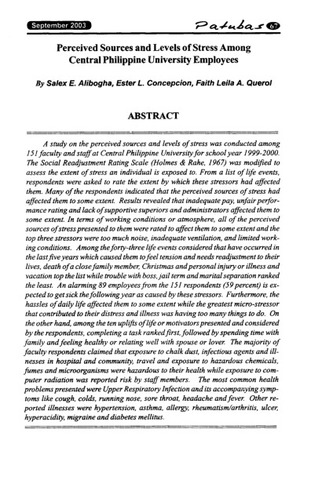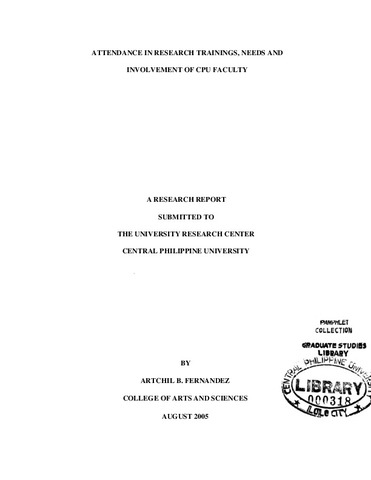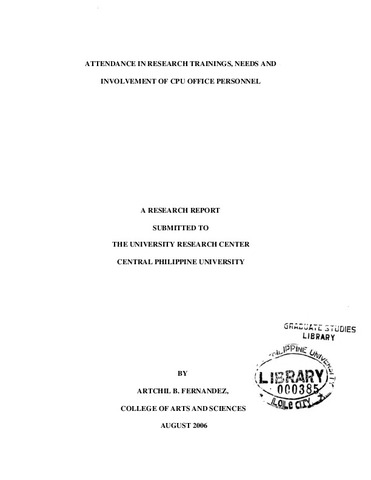Access, attitude, and use of instructional media among the faculty of the University of San Agustin

Page views
815Date
2014Author
Thesis Adviser
Defense Panel Chair
Share
Metadata
Show full item record
Abstract
This study was conducted to determine the access, attitude, and use of instructional media among the faculty of the University of San Agustin.
The respondents of the study were the full-time faculty members from six departments/colleges. Based on the total population of 198 faculty members, the sample size of 135 was obtained from different colleges where they are teaching.
The descriptive correlation was employed in this study to determine the access, attitude, and use of instructional media.
Stratified random sampling was utilized to determine the number of respondents of the study. The researcher-made instrument was used in the study, which comprised two parts. The first part contained the personal profile of the respondents such as sex, teaching experience, subject taught, highest educational attainment, and academic rank and the second part dealt with the access, attitude, and use of instructional media. The instrument was subjected to content validation and reliability testing. Frequency distribution, mean, percentage, and Chi-Square were the statistical tools employed in the study in order to analyze the data gathered.
The result of the study revealed that most of the respondents were female. This implies that there were more female faculty members than male from various colleges surveyed of the University. A group of respondents was from the College of Arts and Sciences because most of the general subjects belonged to this department. A good number of years in teaching ranged from 11 years to 20 years. This implied that the university teaching staff were experienced teachers, having more active years to spend in the service of their respective department in the university. Most of the respondents earned a Master’s degree and most of them were assistant/associate professors. This is a good indication that they are fervent to improve their professional growth. This also implies due to the nature of the institution as a university and employment standards set by the Commission on Higher Education and the accrediting agency (PAASCU). With the highest educational attainment accompanied their academic rank.
Most of the instructional media, which were not accessed by the respondents, were the following: materials -slide (filmstrips, card film slide), audio (cassette tape), chart, map, audio (CD/DVD), and equipment -VHS player, karaoke, multimedia equipment. These attributes were not significant to the needs of modem technology.
Overall, the respondents had access to instructional media.
Respondents perceived positively the usefulness of instructional media in teaching and learning.
Large quantities of instructional media materials and equipment were not utilized by the respondents. Most of the materials that were not utilized were video (VHS tape), transparency, audio (CD/DVD), map, chart, slide (filmstrip, card film slide) and audio (cassette tape). For equipment, multimedia projector, overhead projector, VHS player and Portable Sound System (Karaoke) were not utilized. This implies that most of the instructional media holdings were not relevant in today’s context except for multimedia. Overall, the respondents utilized the instructional media.
Access to instructional media was significantly related to the subjects taught and educational attainment of the respondents but not to gender, teaching experience and academic rank.
The respondents’ attitude towards the use of instructional media was not significantly associated to their sex, length of teaching experience, subjects taught, educational attainment, and academic rank.
The utilization of library instructional media was significantly associated to the length of teaching experience and subjects taught did not influence the teacher’s use of instructional media.
The respondents’ attitude towards the use of instructional media was not influenced by their access to instructional media.
The respondents’ utilization of instructional media was significantly associated to their access to instructional media. The respondents’ use of instructional media was not influenced by their attitude towards it.
The study concluded that faculty members were accessing the instructional media, most of them have positive attitude towards the use of instructional media and they utilized the instructional media to attain educational outcomes.
Description
Abstract only
Suggested Citation
Debalucos, R. P. (2014). Access, attitude, and use of instructional media among the faculty of the University of San Agustin (Unpublished Master's thesis). Central Philippine University, Jaro, Iloilo City.
Type
ThesisSubject(s)
Department
School of Graduate StudiesDegree
Master of Library and Information ScienceShelf Location
GSL Theses 020.72 D35
Physical Description
xiii, 101 leaves
Collections
Related items
Showing items related by title, author, creator and subject.
-
Perceived sources and levels of stress among Central Philippine University employees
Alibogha, Salex E.; Concepcion, Ester L.; Querol, Faith Leila A. (Central Philippine University, 2003-09)A study on the perceived sources and levels of stress was conducted among 151 faculty and staff at Central Philippine University for school year 1999-2000. The Social Readjustment Rating Scale (Holmes & Rahe, 1967) was ... -
Attendance in research trainings, needs and involvement of CPU faculty
Fernandez, Artchil B. (Central Philippine University, 2005-08)The study was conducted mainly to determine the attendance in research trainings, needs and research involvement of CPU faculty. It utilized a one-shot survey design. Using Slovin’s formula, a sample of 206 faculty members ... -
Attendance in research trainings, needs and involvement of CPU office personnel
Fernandez, Artchil B. (Central Philippine University, 2006-08)The study was conducted mainly to determine the attendance in research trainings, needs and research involvement of CPU office personnel. It utilized a one-shot survey design. Using census technique (total enumeration), ...





